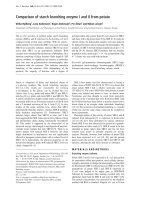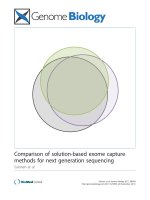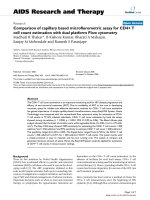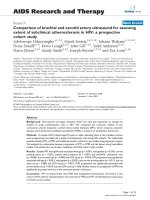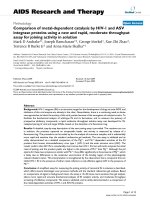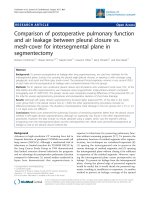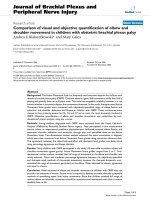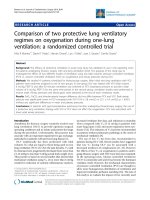Báo cáo y học: "Comparison of procalcitonin (PCT) and C-reactive protein (CRP) plasma concentrations at different SOFA scores during the course of sepsis and MODS" pot
Bạn đang xem bản rút gọn của tài liệu. Xem và tải ngay bản đầy đủ của tài liệu tại đây (1.17 MB, 6 trang )
Comparison of procalcitonin (PCT) and C-reactive protein (CRP)
plasma concentrations at different SOFA scores during the
course of sepsis and MODS
Michael Meisner, Klaus Tschaikowsky, Thomas Palmaers and Joachim Schmidt
Objectives: The relation of procalcitonin (PCT) plasma concentrations
compared with C-reactive protein (CRP) was analyzed in patients with different
severity of multiple organ dysfunction syndrome (MODS) and systemic
inflammation.
Patients and methods: PCT, CRP, the sepsis-related organ failure assessment
(SOFA) score, the Acute Physiology, Age, Chronic Health Evaluation (APACHE)
II score and survival were evaluated in 40 patients with systemic inflammation
and consecutive MODS over a period of 15 days.
Results: Higher SOFA score levels were associated with significantly higher
PCT plasma concentrations (SOFA 7–12: PCT 2.62ng/ml, SOFA 19–24: PCT
15.22ng/ml) (median), whereas CRP was elevated irrespective of the scores
observed (SOFT 7–12: CRP 131mg/l, SOFT 19–24: CRP 135mg/l). PCT of
non-surviving patients was initially not different from that of survivors but
significantly increased after the fourth day following onset of the disease,
whereas CRP was not different between both groups throughout the whole
observation period.
Conclusions: Measurement of PCT concentrations during multiple organ
dysfunction syndrome provides more information about the severity and the
course of the disease than that of CRP. Regarding the strong association of
PCT and the respective score systems in future studies we recommend
evaluation also of the severity of inflammation and MODS when PCT
concentrations were compared between different types of disease.
Address: Department of Anaesthesiology,
University of Erlangen-Nuremburg, Krankenhausstr.
12, D-91054 Erlangan, Germany.
Correspondence: Dr med Meisner, Department of
Anesthesiology, University of Jena, Bachstr. 18,
D-07743 Jena. Tel: ++49 3641 933041;
e-mail:
Keywords: SOFA, CRP, MODS, procalcitonin,
PCT, sepsis
Received: 28 February 1998
Revisions requested: 18 May 1998
Revisions received: 11 January 1999
Accepted: 12 February 1999
Published: 16 March 1999
Crit Care 1999, 3:45–50
The original version of this paper is the electronic
version which can be seen on the Internet
(). The electronic version may
contain additional information to that appearing in
the paper version.
© Current Science Ltd ISSN 1364-8535
Research paper 45
Introduction
Procalcitonin (PCT) is a precursor protein of the
hormone calcitonin with a molecular weight of approxi-
mately 13kDa. PCT is induced in the plasma of
patients with severe bacterial or fungal infections or
sepsis [1,2]. PCT concentrations up to 1000ng/ml and
above are observed during severe sepsis and septic
shock [2–5]. Local bacterial infections, viral infections,
autoimmune and allergic disorders do not induce PCT.
At present, it is not clear whether PCT is predominantly
influenced merely by inflammation induced by micro-
bial infections, or also by the severity of multiple organ
dysfunction secondary to the systemic inflammatory
response. Recent investigations have mainly focused on
sepsis-related severity scores, eg the American College
of Chest Physicians/Society of Critical Care Medicine
Consensus Conference (ACCP/SCCM) criteria [6–8] or
related scores [9,10], but have not yet examined the
relation of PCT concentrations to multiorgan dysfunc-
tion independent from the etiology of sepsis. However,
in severely ill patients presenting with symptoms of sys-
temic inflammation or septic shock, the presence or
absence of a significant infection cannot always be spec-
ified, eg positive bacterial cultures can be isolated with
increasing quantity in patients with increasing severity
of disease [11]. We thus investigated the relation
between PCT concentrations and the severity of organ
dysfunction assessed by the sepsis-related organ failure
assessment (SOFA) score in patients with multiple
organ dysfunction syndrome (MODS) secondary to sys-
temic inflammation of infectious or non-infectious
origin. The SOFA score is a multiorgan dysfunction
score system and estimates organ dysfunction (Table 1)
[12]. We also measured the Acute Physiology, Age,
Chronic Health Evaluation (APACHE) II score [13] and
compared PCT with the widely known marker of the
inflammatory response, the acute phase C-reactive
protein (CRP). Since PCT is also reported as an inter-
esting parameter to estimate the prognosis of sepsis and
severe systemic inflammatory response [4,10,14–19], we
also compared the course of concentrations in patients
when classified as survivors and non-survivors.
Methods
Forty patients of an anaesthesia and surgery intensive care
unit in a tertiary health care institution were prospectively
included into the study when systemic inflammatory
response syndrome (SIRS) or sepsis criteria according to
the ACCP/SCCM definitions [7] were fulfilled for a
period of no longer than 24h. Patients with SIRS or sepsis
were not separately analysed, since distinction between
infectious and non-infectious etiology of systemic inflam-
mation and MODS is often difficult in severely ill
patients, and this was not an objective of our study. PCT
and CRP plasma concentrations, the SOFA score [12] and
the APACHE II score [13] were determined daily on
observation day 1 to 5, and on days 8 and 15 after onset of
symptoms of SIRS or sepsis. Patients were followed-up for
28 days and were then assigned to the group of survivors
and non-survivors, respectively. Sixteen patients survived
and 14 patients had a lethal outcome in the further course of
the disease within the 28-day observation period. PCT was
measured by an immunoluminometric ‘LUMItest
®
PCT’-kit
(B.R.A.H.M.S. – Diagnostica GmbH, Berlin, Germany) and
CRP by the ‘Turbi-Quanti’ method (Behring, Marburg,
Germany).
Statistics
The correlations between the SOFA score and CRP and
PCT concentrations were calculated. Since PCT concen-
trations were not normally distributed, PCT data were
analyzed using four categories of the SOFA to which
patients were assigned, and the median and 25/75 and
10/90 percentiles were determined. Differences of median
PCT levels between these SOFA groups were analyzed
by the Mann–Whitney U test. By definition of four cate-
gories, data were comparable with other semi-quantitative
scoring systems of the septic response, eg the previously
published relation to ACCP/SCCM criteria [4,5]. Signifi-
cance was assumed when P<0.05.
Results
Forty patients with SIRS or sepsis were included in the
study and finally evaluated on a total of 316 observation
days. Fourteen patients died from their underlying disease
during the observation period of 28 days. The data at the
time of enrolment (observation day 1) are shown both for
survivors and non-survivors (Table 2).
SOFA score: comparison with PCT and CRP
For all patients observed, PCT and CRP concentrations
within the four groups of increasing categories of the
SOFA score are shown in Figs 1 and 2. Median of PCT
concentrations significantly increased with increasing
SOFA score levels of the patients (Fig 1). In contrast,
CRP concentrations were found highly elevated also at
low SOFA scores and showed no significant difference
between these groups (Fig 2). Only a few measurements
detected very high PCT levels, whereas the majority of
the PCT concentrations are in the intermediate range.
Thus, correlation coefficients between PCT levels and
SOFA scores were low (r=0.20). Likewise, there was only
a weak correlation between SOFA scores and CRP levels
(r=0.19). Similar data were obtained for the APACHE II
score (r=0.17 and r=0.07, respectively; Table 3).
46 Critical Care 1999, Vol 3 No 1
Table 1
The sepsis-related organ failure assessment (SOFA) score evaluation system of multiple organ dysfunction [12]. Six organ
systems are evaluated as a scale of 1–4 each. The arithmetical sum of these six is the value of the SOFA score.
Score points 1 2 3 4
Respiration
PaO
2
/FiO
2
<400 <300 <200 <100
with respiratory support with respiratory support
Coagulation
Platelets ×10
3
/mm
3
<150 <100 <50 <25
Liver
Bilirubin mg/dl 1.2–1.9 2.0–5.9 6.0–11.9 >12.0
Cardiovascular
Hypotension
a
MAP <70mmHg Dopamine ≤5 or Dopamine >5 or Dopamine >15 or
dobutamine in any dose epinephrine ≤0.1 or epinephrine >0.1 or
norepinephrine ≤0.1 norepinephrine >0.1
Central nervous system
Glasgow Coma Scale 13–14 10–12 6–9 <6
Renal
Creatinine mg/dl 1.2–1.9 2.0–3.4 3.5–4.9 5.0
or urine output or <500ml/24h or <200ml/24h
a
Adrenergic agents administered for at least 1h (doses are given inµg/kg/min). MAP, mean arterial pressure.
The course of PCT and CRP: relation to the outcome
During the first 4 days after the onset of systemic inflam-
mation and MODS, PCT concentrations of patients who
survived were not significantly different from those who
died (Fig 3). In both groups, median PCT concentrations
initially declined, indicating a decrease of the initially
observed systemic inflammation during the further course
of the disease. This decline continued in the group of
patients who survived, whereas PCT concentrations
started to increase in the non-survivors after observation
day 4 (P<0.01). CRP levels were marginally higher in
patients who survived than in non-survivors. However,
plasma concentrations were not significantly different
between survivors and non-survivors on all observation
days except day 2 (197 versus 129mg/l, P<0.01) (Fig 4).
Discussion
Our results indicate that PCT concentrations are associ-
ated with the severity of MODS as assessed by the
SOFA score. These results are in general agreement with
studies in which PCT levels were compared with the
severity of sepsis by sepsis-related score systems. The
similar observations made by sepsis-related score
systems of the inflammatory response and MODS-
Research paper PCT and CRP plasma concentrations Meisner et al 47
Table 3
Procalcitonin (PCT) plasma concentrations of patients with
systemic inflammatory response syndrome (SIRS) or sepsis
and subsequent multiple organ dysfunction syndrome (MODS)
within four categories of the APACHE II score
APACHE II <10 10–19 20–29 >29
PCT 1.46 1.70 3.62* 9.90*
(µg/l) (0.57–2.35) (0.67–2.67) (1.60–9.44) (4.34—23)
CRP 54.85 122 136 133
(mg/ml) (52.4–49) (82.3–174) (94.3–194) (94.3–190)
n 2 54 193 133
Indicated are median, 25/75 percentiles and 10/90 percentiles of PCT
concentrations obtained from 40 patients during a 15-day observation
period. *P<0.0001, versus the preceding category (Mann–Whitney
U-test); n, number of observations. CRP, C-reactive peptide;
APACHE, Acute Physiology, Age, Chronic Health Evaluation.
Table 2
Comparison of the data at time of enrolment of patients
comprising the two groups: survivors and non-survivors. There
was no significant difference for any of the variables between
groups (
P
>0.05, Mann–Whitney U-test)
Survivors Non-survivors
Sex m: 16 f: 10 m: 8 f: 6
Age (years) mean 56.27 61.17
±1SD 14.01 15.62
SOFA score, median 12 13
±25%/75% percentile 10/13 10/15
APACHE II score, median 23 2
±25%/75% percentiles 21/269 24/30
PCT (µg/l), median 5.83 4.42
25%/75% percentiles 2.50–23.96 1.99/32.14
CRP (mg/l) median 169 147
25%/75% percentiles 136/268 101/216
Duration of follow-up (days) mean 12.9 11.58
±1SD 4.28 4.33
m, Males; f, female; SOFA, sepsis-related organ failure assessment;
APACHE, Acute Physiology, Age, Chronic Health Evaluation; PCT,
procalcitonin; CRP, C-reactive peptide.
Figure 1
Procalcitonin (PCT) plasma concentrations of patients within four
categories of the sepsis-related organ failure assessment (SOFA)
score. Indicated are median (l), 25/75 percentiles (box) and 10/90
percentiles (whisker) of PCT observations (n) obtained from 40
patients during a 15-day observation period. *P<0.05 compared with
the preceding category (Mann–Whitney U-test).
Figure 2
Plasma concentrations of the corresponding C-reactive protein (CRP)
concentrations of patients within four categories of the sepsis-related
organ failure assessment (SOFA) score. Indicated are median (l),
25/75 percentiles (box) and 10/90 percentiles (whisker) of CRP
concentrations (n) obtained from 40 patients during a 15-day
observation period. *P<0.05 compared with the preceding category
(Mann–Whitney U-test).
weighted score systems can be explained by similar
pathophysiological alterations occurring during advanced
states of sepsis and MODS. Increasing PCT concentra-
tions were previously reported by Zeni et al [5] and
Oberhoffer et al [4] during more severe stages of sepsis
(severe sepsis and septic shock) as defined by the
ACCP/SCCM criteria [7,20]. Also, other authors
observed high concentrations of PCT during septic
shock, and comparable low concentrations during SIRS
or less severe systemic inflammation. In a study by Al-
Nawas et al [6], very low PCT concentrations were mea-
sured during SIRS, but high concentrations when septic
shock was diagnosed. Similar results were published by
Gramm et al [10] and by other authors [1,9].
None of these authors, however, analyzed the severity of
multiple organ dysfunction rather than the severity of
sepsis and systemic inflammation and there are no data
available as to the relation of PCT concentrations and the
severity of multiple organ dysfunction during systemic
inflammation. By using the SOFA score, we thus focused
particularly on the extent of multiorgan dysfunction rather
than the severity or type of inflammatory response or
infection. This approach is closer to clinical conditions,
since in severely ill patients the presence or absence of a
significant infection cannot always be specified [11].
With increasing categories of the SOFA score, reflecting
the severity of MODS, higher PCT concentrations were
observed. However, PCT should not serve as a surrogate
marker for the severity of MODS, since the correlation of
PCT concentrations and score values is weak.
These findings have an impact on the interpretation and
design of comparative clinical studies using PCT. When
PCT levels are to be compared between different groups
of patients, eg for purposes of differential diagnosis,
assessment of the severity of the disease and of systemic
inflammation, including the severity of MODS, is manda-
tory. When patients were not stratified clearly enough for
severity of MODS and systemic inflammation in clinical
studies, imbalances between groups as to the severity of
MODS or sepsis may significantly influence the signifi-
cance of different PCT concentrations between the
respective groups. We therefore suggest that in future
studies score systems evaluating not only the severity of
systemic inflammation, but also of MODS should be
assessed along with PCT concentrations. This way, imbal-
ances between groups as to severity of inflammation or
MODS can be minimized.
PCT has several advantages in severely ill patients com-
pared with CRP. The most striking one, demonstrated in
this study, is the enormous range of PCT reactivity result-
ing in a marked increase in PCT plasma levels, especially
during severe stages of MODS and systemic inflamma-
tion. On the other hand, PCT concentrations are quite low
when only a moderate organ dysfunction or a weak sys-
temic inflammatory response is present. In contrast, CRP
levels are often found to be already increased to maximal
48 Critical Care 1999, Vol 3 No 1
Figure 3
Course of procalcitonin (PCT) plasma concentrations in 40 patients
during 15 days after onset of sepsis or multiple organ dysfunction
syndrome (MODS). Indicated are median and 25/75 percentiles
(whiskers) of PCT concentrations of 14 patients with a lethal outcome.
(l, solid line) during a 28-day observation period due to the underlying
disease, and of 26 patients who survived (¡, dashed line).
Figure 4
The course of C-reactive protein (CRP) plasma concentrations in 40
patients during 15 days after onset of sepsis or multiple organ
dysfunction syndrome (MODS). Indicated are median and 25/75
percentiles (whiskers) of CRP concentrations of 14 patients with a
lethal outcome (l, solid line) during a 28-day observation period due
to the underlying disease, and of 26 patients who survived (¡, dashed
line).
concentrations in patients with low SOFA scores. Thus,
CRP cannot provide information as to further increases in
organ dysfunction and the inflammatory progress, respec-
tively, since it is already increased to its maximum values
during a less severe stage of disease. Further advantages
of PCT are its more rapid kinetics; PCT reacts faster than
CRP both during an increase or decrease of inflammation.
Although data were not presented, a more rapid increase
of PCT was observed also in this study [17]. This observa-
tion was already described by several authors and thus is
not focused on within this study, eg after experimental
administration of lipopolysaccharide [21] or accidental
application of a microbial contaminated infusion [22],
where PCT increased within 6h after the initial stimulus
and CRP did not significantly increase before 12h after
onset of induction. Also, under clinical conditions, a more
rapid increase of PCT compared with CPR was described
after the onset of severe inflammation [23]. Moreover, the
decline of PCT concentrations occurs more rapidly than
that of CRP [2,23]. In this study, a rapid decline of PCT
levels in patients who recovered and survived was also
observed (Fig 3), whereas CRP increased for several days
even after recovery and discharge of the patient from the
intensive care unit (Fig 4).
Regarding the prognosis of the disease, the course of PCT
after day 4 from the onset of systemic inflammation was
able to distinguish survivors from non-survivors. Until
day 4, PCT concentrations were not statistically different
in the groups. Likewise, the initial height of the PCT con-
centrations did not correlate with the further course of the
disease. The results of this analysis should not be over-
interpreted. The number of patients is too small and too
heterogeneous for a general conclusion regarding the
absolute height of PCT concentrations and estimating the
prognosis of the disease by PCT. In a clinical study, Ober-
hoffer et al report high PCT levels in patients with poor
prognosis already during the onset of the disease [4].
Further studies support the notion that the course of PCT
concentrations rather than the absolute height is a mirror
of the systemic inflammatory response and plays a major
role for prognosis [4,10,18,19]. Also with regard to this
aspect, PCT is superior to CRP, since patients with a
lethal outcome were not distinguished by CRP at any time
in our study. A recently conducted animal study by Nylen
et al [24] suggests that PCT might be a significant lethal
factor during sepsis. In this experimental study, PCT sig-
nificantly increased mortality in a hamster endotoxin
shock model, and anti-PCT reactive antiserum was pro-
tective as to survival.
In summary, PCT compared with CRP is characterized by
its ability to be induced to very high serum concentrations
also during advanced stages of MODS and severe sys-
temic inflammation, respectively, whereas CRP is often
already in the upper concentration range, even in patients
with low severity scores, and exhibits no such further
dynamics during the course of MODS and systemic
inflammation. PCT more rapidly declines to the normal
range during the recovery of the patient compared with
CRP, and thus provides more information in patients with
MODS and sepsis of various etiology than CRP. The
absolute height of PCT concentrations in the initial period
of inflammation was found to be less important than the
further course of its plasma concentrations. The strong
association of high PCT concentrations with both the
SOFA and the APACHE II score indicates that not only
sepsis-related score systems, but also a MODS-related
evaluation of the severity of the diseases should be consid-
ered when PCT concentrations of different types of
disease were compared.
References
1. Assicot M, Gendrel D, Carsin H, et al: High serum procalcitonin con-
centrations in patients with sepsis and infection. Lancet 1993;
341:515–518.
2. Meisner M: PCT, procalcitonin — a new, innovative infection parame-
ter. Berlin: B R A H M S-Diagnostica GmbH; 1996.
3. Meisner M, Tschaikowsky K, Beier W, et al: Procalcitonin (PCT) — ein
neuer Parameter ur Diagnose und Verlaufskontrolle von bak-
teriellen Entzündungen und Sepsis. Anästhesiologie und Inten-
sivmedizin 1996; 10:529–539.
4. Oberhoffer M, Bögel D, Meier-Hellmann A, et al: Procalcitonin is
higher in non-survivors during the clinical course of sepsis, severe
sepsis and septic shock. Intensive Care Med 1996; 22:A245.
5. Zeni F, Viallon A, Assicot M, et al: Procalcitonin serum concentrations
and severity of sepsis. Clin Intens Care 1994; 5 (suppl 2):89–98.
6. Al-Nawas B, Krammer I, Shah PM: Procalcitonin in diagnosis of
severe infections. Eur J Med Res 1996; 1:331–333.
7. Anonymous: American College of Chest Physicians/Society of
Critical Care Medicine Consensus Conference: definitions for
sepsis and organ failure and guidelines for the use of innovative
therapies in sepsis. Crit Care Med 1992; 20:864–874.
8. Oberhoffer M, Bitterlich A, Hentschel T, et al: Procalcitonin (ProCT)
correlates better with the ACCP/SCCM consensus conference
definitions than other specific markers of the inflammatory
response. Clin Int Care 1996; 7 (suppl 1):46.
9. de Werra I, Jaccard C, Corradin SB, et al: Cytokines, nitrite/nitrate,
soluble tumor necrosis factor receptors, and procalcitonin concen-
trations: comparisons in patients with septic shock, cardiogenic
shock, and bacterial pneumonia. Crit Care Med 1997; 25:607–613.
10. Gramm H-J, Dollinger P, Beier W: Procalcitonin — ein neuer Marker
der inflammatorischen wirtsantwort. Longitudinalstudien bei
Patientenmit sepsis und Peritonitis. Chir Gastroenterol 1995; 11
(suppl 2):51–54.
11. Rangel-Frausto MS, Pittet D, Costigan M, et al: The natural history of
the systemic inflammatory response syndrome (SIRS). JAMA
1995; 273:117–123.
12. Vincent JL, Moreno R, Takala J, et al: The SOFA (Sepsis-related
Organ Failure Assessment) score to describe organ dysfunction/
failure. Intensive Care Med 1996; 22:707–710.
13. Knaus W, Draper E, Wagner D, et al: APACHE II: a severity of
disease classification system. Crit Care Med 1985; 13:818–832.
14. Gramm HJ, Beier W, Zimmermann J, et al: Procalcitonin (ProCT) – a
biological marker of the inflammatory response with prognostic
properties. Clin Intens Care 1995; 6 (suppl 2):71.
15. Meisner M, Tschaikowsky K, Palmaers T, et al: Prognostische Bedeu-
tung von Procalcitoninn (PCT) bei Patienten mit Sepsis und sys-
temischer Inflammation. Anaesthesiol Intensivmed Notfallmed
Schmerzther 1997; 32:177.
16. Meisner M, Tschaikowsky K, Spiessl C, et al: Procalcitonin — a marker
or modulator of the acute immune response? Intensive Care Med
1996; 22 (suppl 1):14.
17. Palmaers T: Procalcitonin bei Sepsis und Ganzkörperinflammation:
Prognostische Aussagekraft und ein Vergleich mit C-reactivem
Protein. Germany: University of Erlangen; 1998.
Research paper PCT and CRP plasma concentrations Meisner et al 49
18. Reith HB, Lehmkuhl P, Beier W, et al: Procalcitonin – ein prognos-
tischer Infektionsparameter bei der Peritonitis. Chir Gastroenterol
1995, 11 (suppl 2):47–50.
19. Reith HB, Mittelkötter U, Debus ES, et al: Procalcitonin (PCT)
immunoreactivity in critical ill patients on a surgical ICU. In: Mon-
duzzi (editor). The Immune Consequences of Trauma, Shock and
Sepsis. Bologna 1997; 1:673–677.
20. Bone RC: Definitions for sepsis and organ failure. Crit Care Med
1992; 19:973–976.
21. Dandona P, Nix D, Wilson MF, et al: Procalcitonin increase after
endotoxin injection in normal subjects. J Clin Endocrinol Metab
1994; 79:1605–1608.
22. Brunkhorst FM, Forycki ZF, Wagner J: Release and kinetics of pro-
calcitonin (PCT) after Gram-negative bacterial injection in a
healthy subject. Shock 1997; 7:124.
23. Monneret G, Labaune JM, Isaac C, et al: Procalcitonin and C-reac-
tive protein levels in neonatal infections. Acta Paediatr 1997;
86:209–212.
24. Nylen ES, Whang KT, Snider RH, et al: Mortality is increased by pro-
calcitonin and decreased by an antiserum reactive to procalcitonin
in experimental sepsis. Crit Care Med 1998; 26:1001–1006.
50 Critical Care 1999, Vol 3 No 1
